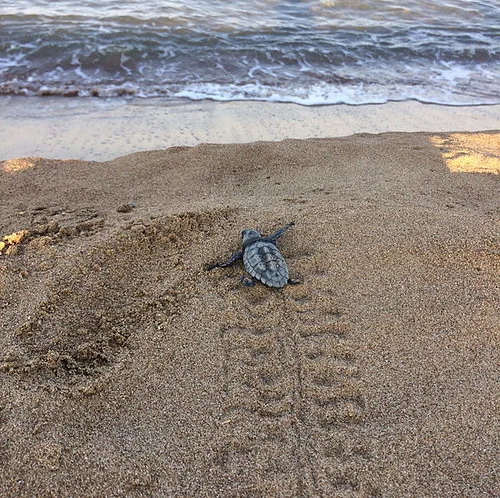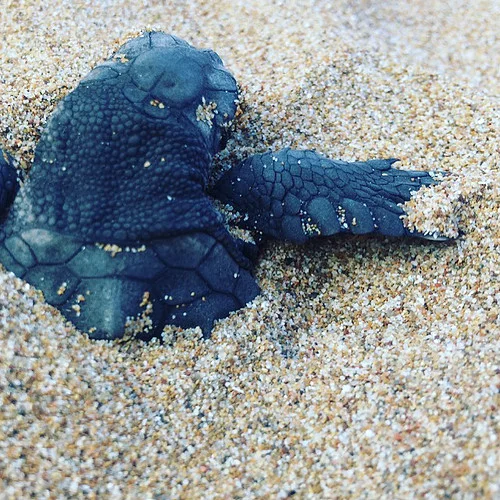How Hot is Too Hot for Our Marine Turtles?
Thomas McQuigg
In recent times, marine turtle numbers have been rapidly declining. Of the 7 species, 6 are classified between vulnerable and endangered. A large part of these declines have been brought about by human causes.
Sea Turtle Hatchling. Photo: Harriet Tyley @harrietyley
One such example is climate change. Over the past 100 years, a warming of 0.6-0.9˚C has been experienced worldwide. Cold-blooded organisms, such as marine turtles, are extremely sensitive to this temperature change, and it has already begun having a negative effect on their survival and reproduction.
The sex of marine turtles is determined by the temperature that the eggs are exposed to in their nests. Higher temperatures produce a higher percentage of females while lower temperatures produce more males. The ideal temperature would produce 50% males and 50% females, coined the pivotal temperature, which in most marine turtles is around 29˚C. Climate change is increasing the temperatures that eggs are exposed to, therefore skewing hatchling sex ratios, with more females being produced.
The effect of this is already being experienced worldwide. For example, since 2007, more than 90% of Loggerhead turtle hatchlings in Florida, and 70% of hatchings in Zakynthos have been female. Beaches on Ascension Island provided one of the most extreme cases to date, with turtle hatchlings thought to have been 100% female for around 150 years.
Unfortunately, conditions are only expected to worsen. We are already observing higher percentages of female hatchlings with a 0.6-0.9˚C temperature increase. By 2090, it has been predicted that global temperatures will have increased by 1.8-4.0˚C. Taking these figures into account, some areas may have 100% feminisation within the next 100 years. By 2150 only 4-17% of the total turtle population may be male. Low levels of males pose a problem as it will impact the number of eggs being fertilised. If eggs are left unfertilised, marine turtle populations will continue to decrease. In addition to this, if temperatures exceed 33˚C, eggs will be exposed to temperatures that prevent the formation of the embryo. Coupled together, these factors could lead to the extinction of marine turtles.
Sea Turtle. Photo: Harriet Tyley @harrietyley
In addition to this, the depth of the nest can influence temperatures experienced. Nests closer to the surface experience greater temperatures, with greater daily fluctuations. These fluctuations lower survivability of the eggs. If eggs are laid at depths greater than 40cm, there are no daily temperature fluctuations. Therefore, eggs laid deeper in the sand produce a higher percentage of males and increase survivorship. However, only larger females can dig nests this deep.
However, there is hope of saving these marine creatures if we implement worldwide conservation strategies quickly. A few solutions to these issues have been put forward with varying success. Lighter sand beaches absorb less solar radiation than darker sand beaches, therefore the eggs on lighter beaches experience lower temperatures, and produce a higher percentage of males. This was seen in Cape Verde, one of the largest sea turtle rookeries worldwide. Darker sand beaches produced 93% females, whereas lighter sand beaches produced only 70% females. One way of protecting these species would be to focus conservation priorities on lighter sand beaches.
Another solution is shading or watering of nests. These interventions have been shown to bring down the temperature of nests and thus, increase the number of males produced. When both shading and watering are combined the temperature of nests is reduced by up to 4˚C and hatchling sex ratios are shifted from 100% female to 100% male. These interventions may go some way to reducing the female bias if implemented quickly and in enough rookeries. However, care must be taken to not skew the sex ratio in the opposite direction.
Another conservation strategy being used is digging out and relocating eggs. Eggs are either relocated to areas with reduced temperatures, or, are moved to hatcheries where temperatures can be controlled. However, these strategies are seen as controversial. These techniques have been shown to increase the percentage of male turtles hatched, but at the expense of about 10% of the eggs being lost. Although, this reduction in number of eggs does have an advantage. In the nest, each egg produces heat as the embryos are metabolising. When the clutch of eggs is smaller, there are less individuals producing heat, reducing the temperature of the nest, and favouring production of males.
Sea Turtle Hatchling. Photo: Harriet Tyley @harrietyley
The same percentage of eggs are lost when relocating to temperature controlled hatcheries. Again, this strategy is producing more males as lower temperatures can be maintained. Both of these strategies are producing the desired results but at a cost. The question is not with the results, but with the ethics of losing individuals while relocating them.
Despite the drawbacks to some of these strategies, if we do not take some form of action now, sea turtles could be lost forever in the next few decades…
If you were unaware before, hopefully this begins to outline the very real problem of global warming to our planet. The majority of climate change is human caused so it is our responsibility to rectify the situation. Countries worldwide are beginning to recognise the significance of global warming but progress towards solutions is being made too slowly. In order to sort this problem everyone needs to do their part, now.



